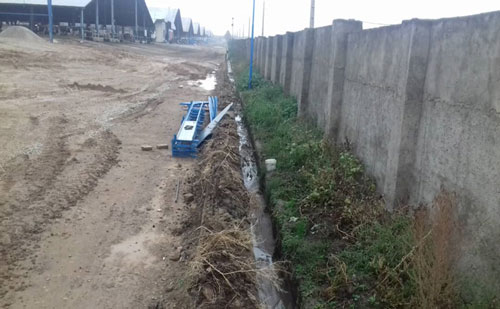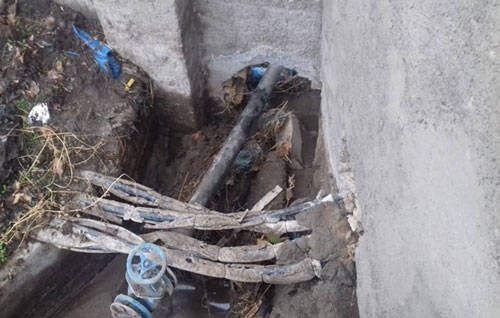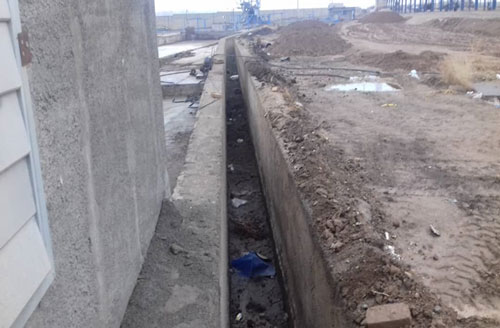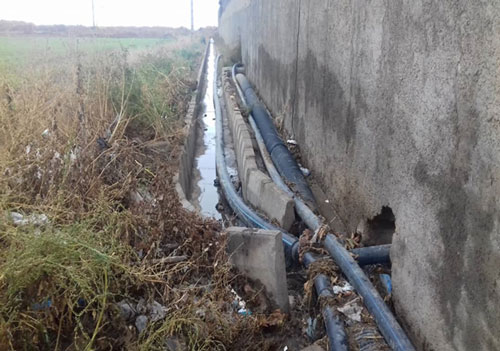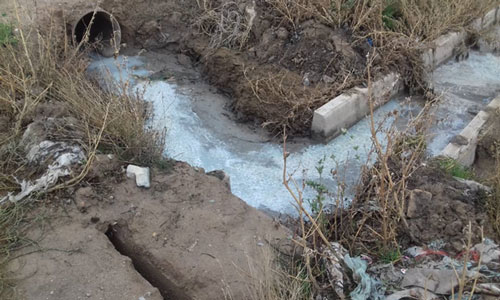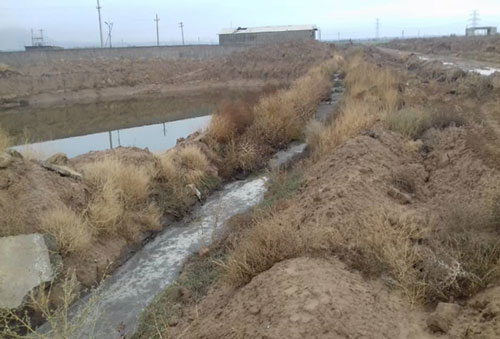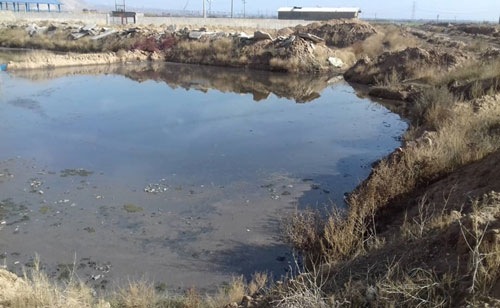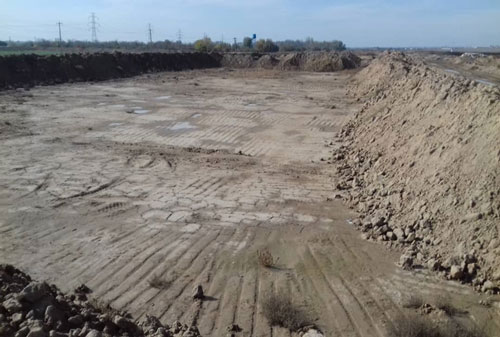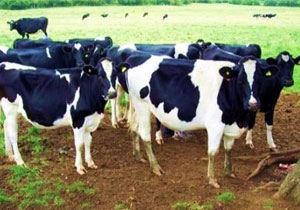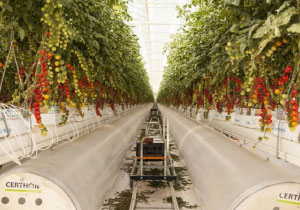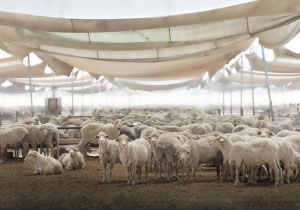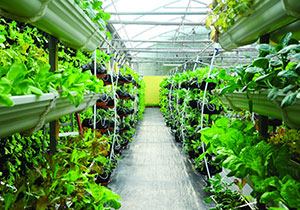Management of compost residue to produce electricity-Studying
- Super User
- Environmental projects
- Hits: 348
Features of accumulation pools of liquid compost.
Agricultural lands engaged so far: Over 9 hectares
Google Earth photo from the location of compost pools.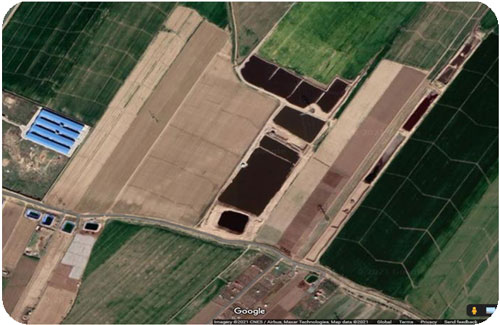
Environmental problems caused by compost earthen pools:
At present, liquid compost backwater exited from Zarin Heev dairy farm is conducted towards fields down the company using some canals and cumulated in totally earthen pools. It takes a long time after evaporation of its liquids (about 4 years) to change into dry compost and become usable. This present system has made plenty of technical, financial and environmental problems:
1- In these pools, cumulated liquid composts whose solids always cover water's surface, it demands a long time for the water existed down these composts to evaporate so that their solids could be separated. Consequently, this engages the fields for a long time and provides a lot of time for polluted waters to leak into down surfaces and underground waters and lead to their pollution.
2- With regard to technical system and the existing pools' being marshy, it is not possible for the workforce and the equipment to work and separate compost from water which it caused several compost pools to be made and most part of the farms to become polluted and unusable.
3-From among other problems of these pools, it can be mentioned that when heavy seasonal raining, the pools' output rate of flow becomes uncontrollable that it makes downstream fields get polluted that it, in turn, results in various environmental problems and the contest of the owners of the said fields.
4-Furthermore, the lands from which they use as earthen pools of compost accumulation, cannot be cultivated in no way even many years after movement and depletion of compost.
Statement of the problem:
In recent decades, because of increasing population and changing classic dairy farms into modern and enormous ones, it is needed to take new measurements to manage compost so that they could keep the system economically strong; and it can supply the current needs of world community. Nowadays, husbandries and especially dairy farms require to be managed effectively in terms of environmental, economical and energy-based subjects. From 1960s, extraction of liquid compost from husbandries has found many proponents, so the process of separating liquid –solid plays an important role in management of manures but knowing the limitations and the fields of their function are also essential.
The advantages of separating manures are the following: improvement of transportation conditions, decreasing danger of water and soil resource pollution, decreasing bothering factors such as stink, meeting health affairs and enjoying value added of products of solid and liquid composts.
Using the equipment separating compost from water, a way to save the time and not to need lots of earthen pools :
In most of the advanced countries, you can see these equipment for instance, in Ontario, Canada, a machine has been built that can enter the compost gathering pools and move solid compost, having several nuzzles; and gather them in one side. This machine has the capacity of moving 12000 gallons of liquid compost (around 45000 liters) per minute. It is an amphibian vehicle that has been designed for arousing lagoons. Having some suckers, it pumps the liquid part of composts and injects them into the lands. After it was made in 2014, demands for Lagoon Crawlers raised; and now, over 175000 machines are working in modern dairy farm.
In this respect, for collecting liquid compost, it is better to determine one pool instead of using a large number of pools and create proper substructures like using geo membrane pools on the pools' floors as they have capability of entering the equipment like logons. Cumulated liquid compost whose solids always cover water's surface, demanding a long time for the water existed down these composts to evaporate so that their solids could be separated by this equipment. In such a way, building geo membrane pools that, in no way, do not let liquid compost penetrate into down surfaces of soil causes the liquids not to need a long time to evaporate and change into a dry and extractable compost. As a result, the environment, underground waters and agricultural parts are not damaged.
The best solutions of optimal use of liquid compost in order to protect the environment and increase the efficiency:
After separating compost's solids by the related machinery, the rested liquid part can be used in agricultural fields and another part applied in the form of Biogas including a mixture of gases, mostly methane and co2, that is produced from raw materials such as agricultural waste, compost, urban waste, Herbal materials, sewerage, green waste or food waste and is a renewable resource of energy.
Biogas and its importance:
Limitations of energy resources and environmental problems arisen from fossil fuel consumption have caused different countries in the world to pay attention to renewable resources. One of these important energy resources is Biogas. It is created by anaerobe fermentation of such resources as animal waste in a container. The main resources of Biogas production are animal wastes, urban and industrial sewerage, rubbish and agricultural wastes. Using Biogas technology is of importance from various aspects: First, because of having high temperature value, it can be used as a fuel in domestic consumptions. Second, using this technology will bear significant social effects in the fields of environment protection and human health. Third, the exited mire from the Biogas unit is an enriched compost that can greatly increase the efficiency of agricultural products.
The advantages of using Biogas:
Finishing the main fossil fuels in the next century
Lacking fueling facilities to remote districts
Meeting the needs to attribute enormous budget for subsidies of fossil fuel consumptions.
Compensating price fluctuations of necessities because of annually gradual increase of fuel price in Iran
Achieving social justice through fueling to all districts
Changing consumption pattern towards economic consumption and proper efficiency
Instituting and developing corporations of Biogas production and creating jobs for the young
Protecting natural green resources (in the recent century, 40 % of jungles of the country have been destroyed because of fuel supply
Biogas institutions cause pastures and jungles to be protected and fuels like wood, coal and oil to be saved and change manures and plant wastes (commonly very harmful for human heath) into organic composts
Using suitable and healthy consumption composts; and the country's independence from imported chemical composts; and decreasing diseases because of eradication of parasite eggs
Being as a new fuel resource for mechanization of agriculture and husbandry
Preventive factors in spreading technologies of Biogas production:
Iran is one of the countries having extensive resources for Biogas production. Considering normal values of Biogas efficiency from manures, agricultural wastes, urban wastes and sewerages, food industry; and applying reliability coefficient, on average, the obtained Biogas will be 16146/35 million m3, equal to 323 petajoule (1015 joule) energy. Unfortunately, in spite of having this high potential and fairly simple technology of Biogas generators and reactors, in the country, these resources are not used suitably at all. The few existing units also do not have ideal efficiency for the reason of administrative problems and lack of accurate conduction.
Almost always, all citizens' life deals with electricity industry. Even some seconds of power outage might endanger their health and security. Therefore, regarding the importance of electricity supply and necessity of making balance between production capacity and demand increase, it is essential to build new power plants to meet the needs completely within the country.
Proposing the design:
Regarding the aforesaid explanations about Biogas and its applications, it is recommended that electricity be produced through constructing Biogas power plants.
The produced biogas, with the capacity of 1 MWH, is based on using manures; after it is transferred to gas filtration system and purified, Methane is conducted to generators. There, Energy is changed into electricity and warm water and consumed. In the site, some special torches are inserted to burn some extra gases. After its production, electricity is connected to the central network of electricity distribution.
The warm produced water can provide very cheap thermal energy to industrial or agricultural institutions, husbandries or residential districts, in the neighborhood of Biogas sites that through building the required substructures, it might be a suitable source of energy.
The advantages of performing this project for ranchers:
Having no need to refineries for refining manures; and consequently economical saving
Decreasing stink of manures
Managing the manures completely and healthily
Providing the complexes' warm water in husbandry fields or other ones
Destroying all pathogens of manures and, as a result, improving husbandries' health as well as significantly decreasing pollution and pathogen factors
Being effective in controlling contagion of infectious diseases such as tuberculosis, salmonella and brucellosis
Having the chance to use dry materials of system output as cattle beds
Having no need to spend budget for purchasing beds
Decreasing the required space for drying composts
Having no need to add Calcium Carbonate to cattle beds
Having effects on decreasing environmental pollutions
Changing liquid composts into high- quality solid ones and earning incomes through them
The advantages of executing the project for investor:
Obtaining economic profits in respect of current economical investigations
Helping technology's entrance
Constructing more power plants
Helping dispersed power production in the country with regard to enormous strategic benefits and according to objectives of Heevco Holding and Nestle Companies
Having extraordinarily positive environmental effects
Regarding the advantages of project's job creating
Using the rested mire as organic composts in the agricultural and horticultural fields.








